The Swedish Navy in WW2
Already the heavyweight of the Scandinavian fleets during the first world war, and despite interwar financianl crisis, budget reduction and general opinion pacifism, Sweden kept a sizeable Navy operational in 1939 that was a credible and serious enouh to enter in German calculation when invading Norway, both in scale and quality. The kriegsmarine was not in tonnage that far away from it. Swedish Neutrality, athough seriously tested and its armies and territory courted by both sides, never took sides until the end of the war.
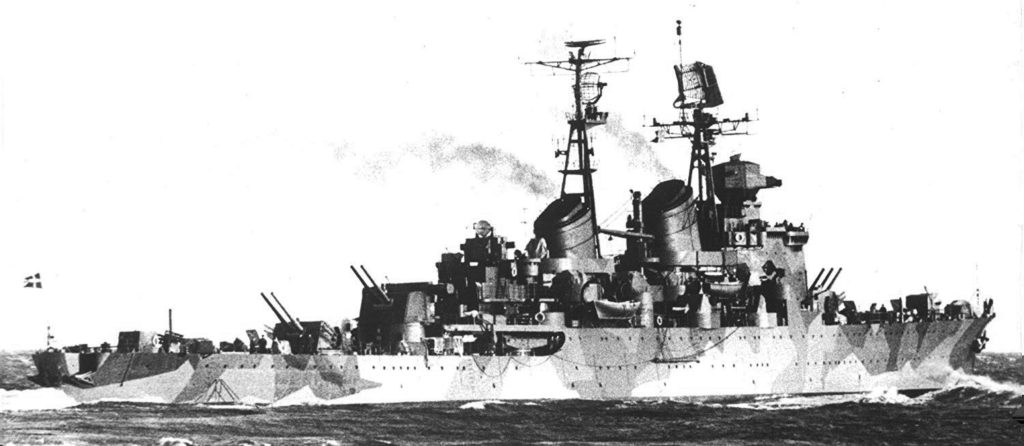
Göta Lejon of the Tre Krono class. This ambitious design was started during the war but completed after. This shows Sweden was perfectly capable to create first-rate cruisers comparable to those of neighbouring Germany and Russia.
Articles published and incoming
- HSwMS Clas Fleming (1912)
- HSwMS Fylgia (1905)
- HSwMS Gotland (1933)
- HSwMS Oscar II (1906)
- Sverige class (1915)
- Tre Kronor class cruisers (1944)
Gustav V class CBBs (1918)
Interwar Swedish CBB projects
Ehrernskjold class DDs (1926)
Psilander class DDs (1926)
Klas Horn class DDs (1931)
Romulus class DDs (1934)
Göteborg class DDs (1935)
Mode class DDs (1942)
Visby class DDs (1942)
Öland class DDs (1945)
Swedish ww2 TBs
Swedish ww2 Submarines
Swedish ww2 Minelayers
Swedish ww2 MTBs
Swedish ww2 Patrol Vessels
Swedish ww2 Minesweepers
A long-standing Naval tradition
The Swedish Navy (Sverige Marinen), since the eighteenth century, was on par with another power of the Baltic: The Russian Navy, operating from St. Petersburg. Great battles took place in these icy and shallow seas, and the Swedes showed technical excellence in the naval field. The refloating of the Vasa (1628) in the 1970s was, in this respect, a rich lesson in the naval techniques of the time, fate late galleons. Sweden remained, until the 1890s, the great naval power of the Baltic, without many rivals but Russia. Germany was long divided into kingdoms and its small naval force was created from scratch from the 1880s. Russia for long had no harbor not military base before Peter the Great made one, whereas Finland was negligible, and Denmark seemed the only potential rival to the West. In fact she was more of a long-time ally.
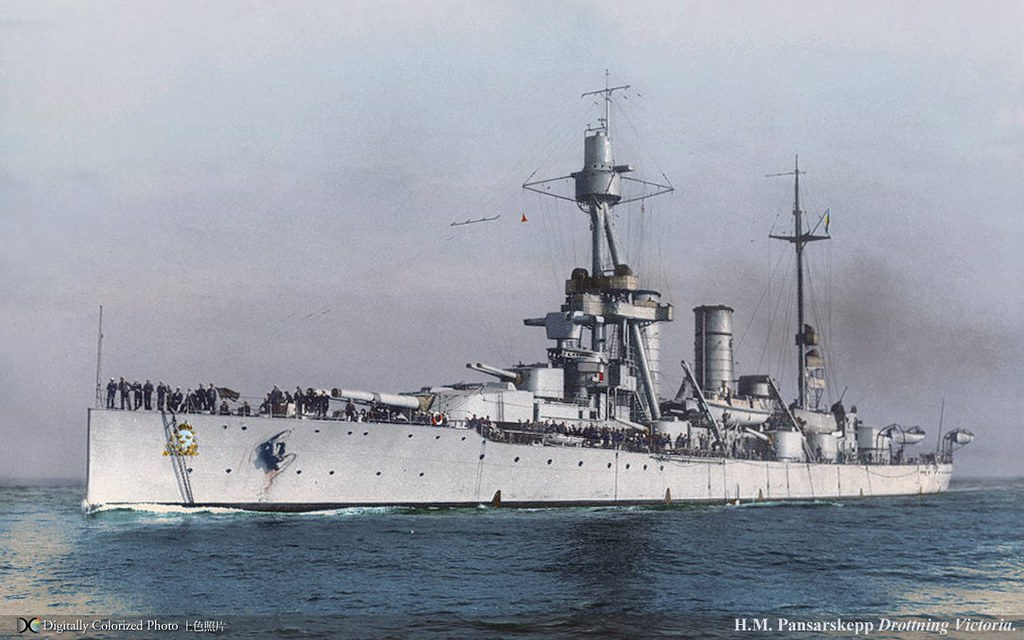
The coastal battleship (Pansarkepp) Drottning Victoria before the war – colorized by Hirootoko Jr.
This Scandinavian naval power was still first in 1914, and maintained its status facing the Kriegsmarine. Although the latter was of a much higher level, the German Baltic fleet was less impressive than the North sea fleet. Sweden’s economic and industrial situation, however, did not allow sufficient resources nor manpower to feed a larger fleet and had no particular naval ambitions at that point but its self defence. This was fleet of coast guards.
This vocation, like all fleets of lesser importance, was above all defensive. By range and nature, the Swedish Navy was in between a true ‘blue water’ bt rather leaning towards a green water navy. In September 1939, Sweden was neutral and its navy was numerically large, well trained and able to use typical defensive tactics to its advantages with mines, submarines and torpedo boats to inflict serious damage. Her coastal battleships were also capable to sink any German cruiser, her aviation and coastal fortifications completed this array.
An almost guaranteed neutrality
Sweden, in short, was not afraid of an invasion attempt on the part of the Reich, atlhough its land armies could have been dealt with by several Panzerdivisions, Sweden had more tanks than any other Scandinavian country combined (68), and a standing army which was very diverse and only professional for its smallest core, but which could be bolstered several fold, between the draft instituted in 1938, the Swedish Home Guard in 1940 and even a corp of voluntary fighting women called the Lottorna since 1924. All in all, this was a virtual pool of millions under arms, on a terrain that favoured defense, dotted with thick forests, marshes and lakes.
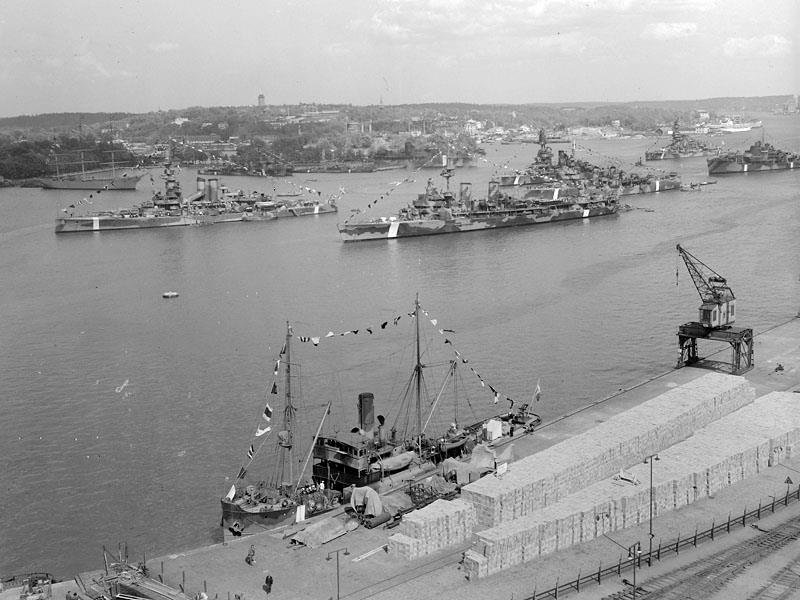
The Swedish Fleet anchored in Stockholm.
The Swedish air force in 1939 was not a joke either, with 158 fighters, 116 bombers, and about 100 reconnaissance planes of diverse origins, British and German. In 1940 serious efforts were made to bolster this force, by purchasing 300 combat aircraft from the United States, Seversky P-35s and P-66 Vanguards, halted after 60 planes by the Government, fearing Sweden’s neutrality would end soon. Sweden turned to Italy for the remainder, 200 aircraft, mostly Fiat CR.42s, Reggiane Re.2000s, and Caproni Ca.313s.
There was no standing naval aviation. Sweden for the Reich was a far less strategically interesting than Norway. Not only the latter was a much easier prey, offering large quantities of metals and an unbeatable operational facade on the North Atlantic. USSR however had views on Sweden. There has been a internal dynamic communist movement in the 1920s, but the Red Army in 1939 first had to defeat Finland before even thinking of attacking Sweden, and the disastrous winter campaign show how foolhardy this enterprise could have been. Sweden was therefore in much better position to defend itself thanks to its armies, the best in Scandinavia by far, and geographical surroundings.
Swedish unsinkable fleet: Coastal Fortifications
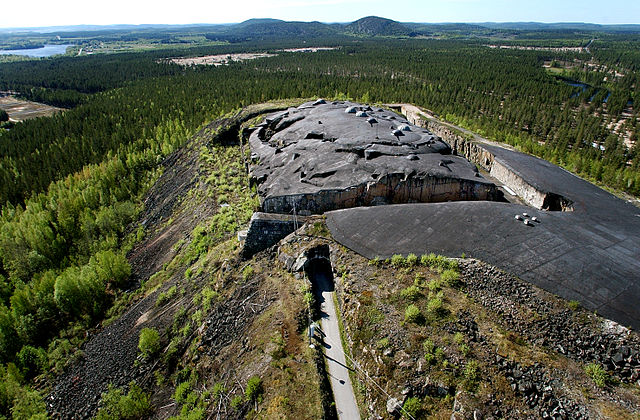
The Boden Fortress: Degerberget Fort Turrets as of 1998, when it was officially discarded.
The Kustartilleriet, or KA emerged in the Archipelago Artillery that raised in 1866. It was reformed in 1902 and spread into three units, including the army and marine regiment, but became an independent branch within the Swedish Navy until July 1, 2000 when it was disbanded and now a part of the amphibious corps. Before WW1, these assets were concretised around the Vaxholm Coastal Artillery Regiment (KA 1) and Karlskrona Coastal Artillery Regiment (KA 2) while regiments were detached to the Fårösund Fortress, the northern tip of Gotland and Älvsborg coastal fortresses, near the main shipping channel into Gothenburg. Later in 1937, the detachment at Fårösund became a separate unit, renamed “Gotland Coastal Artillery Regiment”.
However after WW1 there was a reduction after the 1925 defence proposition. While all the branches of the Swedish Armed Forces were expanded. The Coastal Artillery was modernised either with Swedish guns and imported ones, like from Czechoslovakia. The coastal defensive line of Skåne became Per Albin Line during WW2. The Gothenburg detachement became the Älvsborg Coastal Artillery Regiment in 1942. In all during the war, 60 coastal artillery batteries were built along coast. An additional deterrent for any invasion force.
In 1942 there were new units created (operational also durng the cold war): The Blekinge, Gothenburg, Gotland, Norrland and Stockholm Coastal Artillery Defence units.
On the other hand there were still a number of forts, fortesses and fortified lines built or still in activity during WW2:
-The Boden Fortress (1901-1916). A fortiified line with in total 102 pieces served by 1,868 men spread into in 6 forts and 8 batteries.
-Degerberget Fort (1908) – Part of the Boden line, it was the strongest battery.
-Järflotta Fort (1942): An island in Stockholm archipelago, 5 km south of Nynäshamn. A coastal artillery battery with three 9.4in (24cm 43calibre) Bofors M06 naval guns setup in 1942, completed by a cordon of a total of 291 concrete bunkers with barbed wire and mines.
-Skåne Line (1941): Created by Prime Minister Per Albin Hansson it was long of 500 km, it was made of light fortifications around the coast of southern Sweden, from Halland across Skåne to Blekinge. It consisted of two defensive lines, the first with concrete bunkers, light gunnery emplacements along the shore, and a second line of entrenched troops 300 meters inland, behind mines and barbed wire and a few concrete bunkers. It was to deal against amphibious assaults, not ships. In 1945 it consisted of 1,063 fortifications total and gained 3-in guns during the early cold war.
-Fort Oscar II (Gothenburg) (1907): Included the main fortification of Elfsborg Fortress to protect the sea entrance to Gothenburg. Several heavy gun turrets (8-in).
-Fårösund Fortress (1886): Built to fortify the inlet at Fårö, which possessed three batteries. However it was juged obsolete in the start of the century, became a penitentiary, and the entire fortress was declared a listed building in 1935. Also obsolete in WW2 were the Karlsborg Fortress (until 1925), the Enholmen Fortress (1858), still in use for garrison purposes during WW2. Also the Vaberget Fortress (1902), used until 1927,
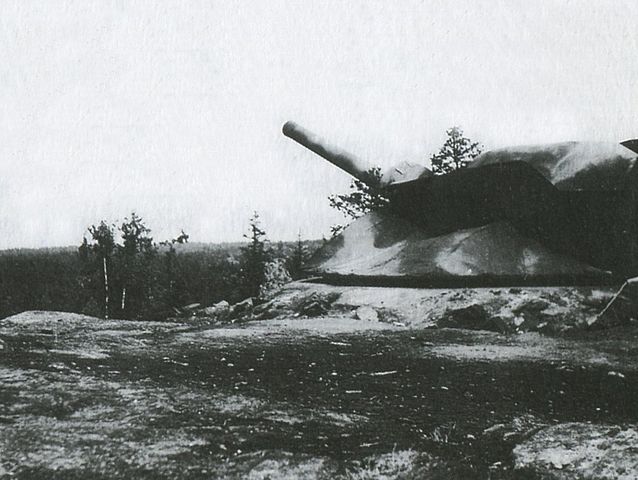
Batteri Järflotta in 1942 – The 9.4in was the heavier fortess gun in service.
A citizen’s funded Navy
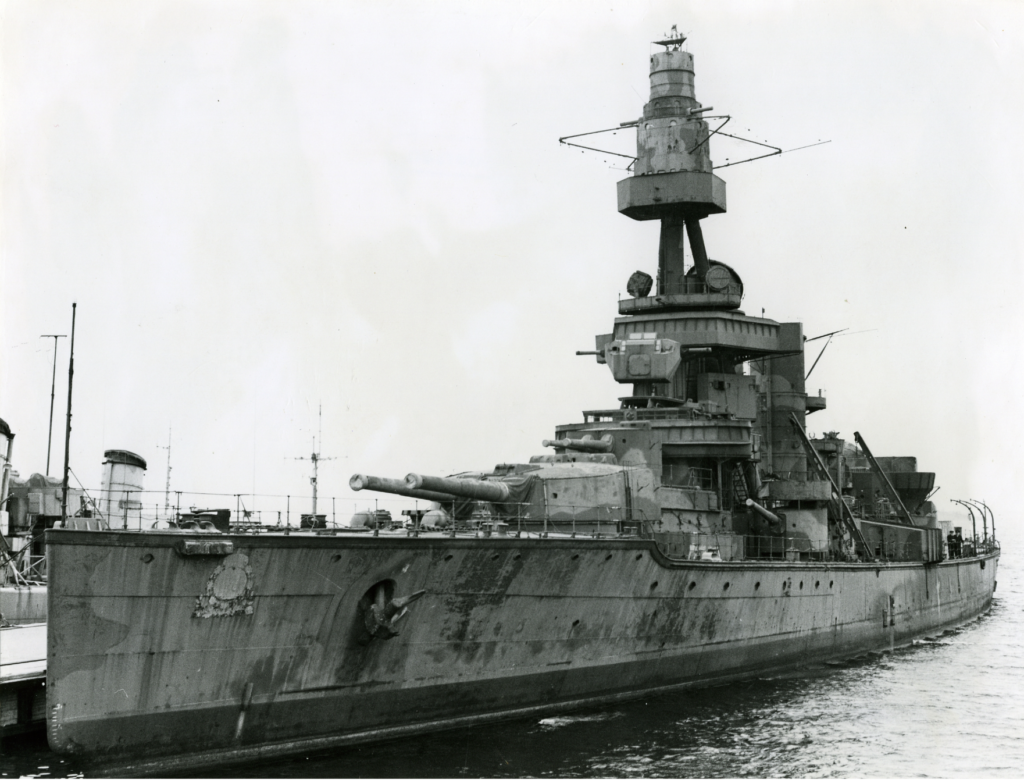
Drottning Victoria after the war -HD photo) – The camouflage seemed ti have been washed out (especially the hull) and neutrality bands has been removed.
One of the peculiarities of Sweden was to have substantial funds to build the ships requested, but little industrial resources to do so. However, after the great war, the pacifist current that passed through the country put an end to new expenses in this matter. Even the nominal operating budget was cut in half. Against all threats, Sweden placed its hopes in the League of Nations. But in 1930, many of these hopes had been shattered. Three years later, the rise of the Third Reich was enough to worry the government, which passed several massive budget increases. Various ships were modernized, single cruiser was built. The naval rearmament law did materialized in 1936.
Therefore, before it came into full force, the Second World War broke out. A large number of these new planned units had to wait, not least modern destroyers, submersibles and the Tre Kronor class cruisers. Also the Swedish naval potential was seriously hampered in 1939. Nevertheless, the plan was realized during the war and until 1947, ready to take on the cold war Soviet challenge.
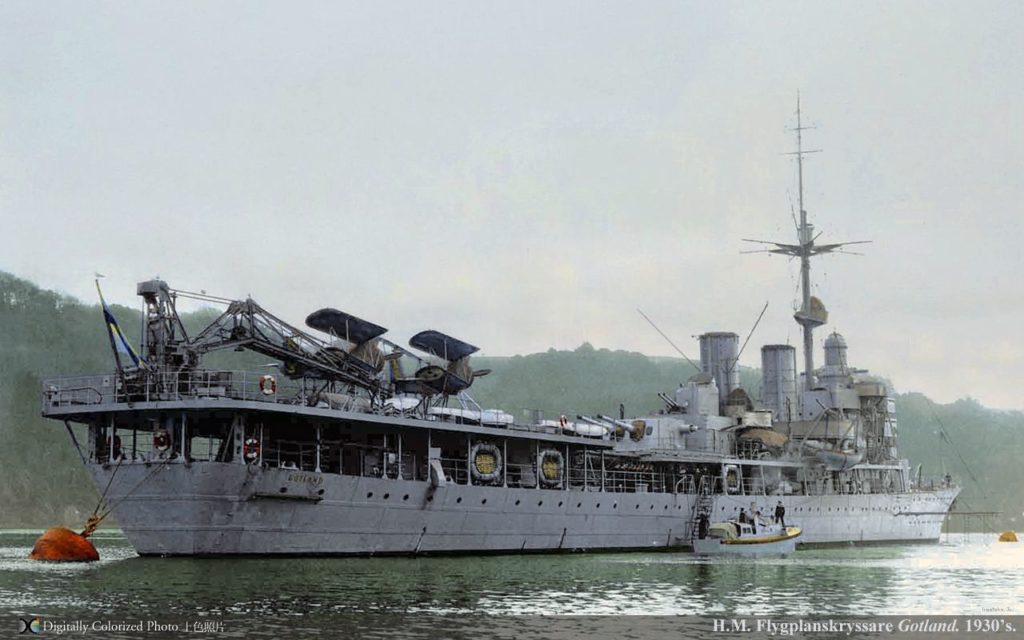
The Götland, colorized by Hirootoko Jr.
Sweden in WW2
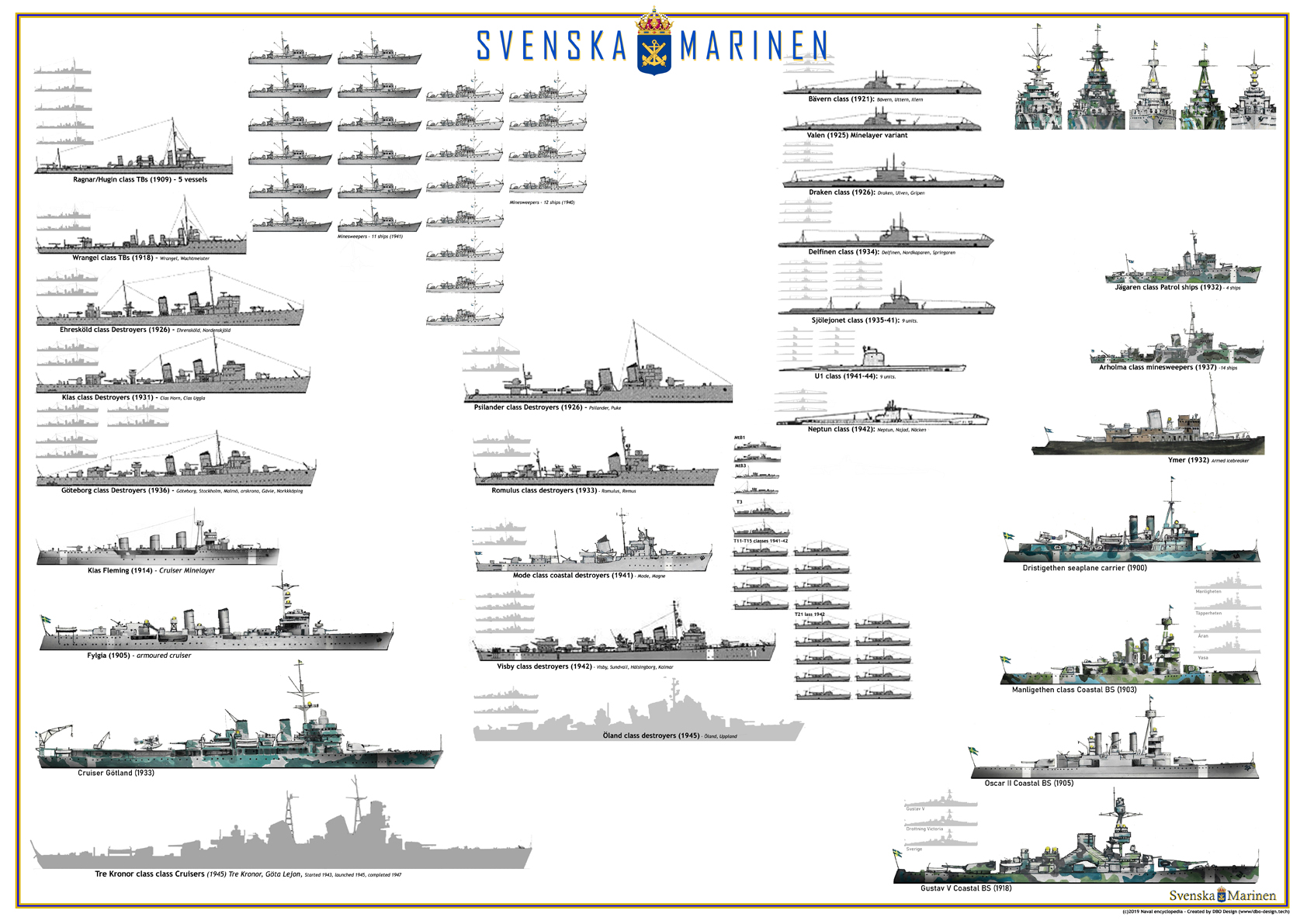
Work in Progress: The Swedish Navy in WW2
Sweden remained neutral, even before the invasion of Finland in the east and Norway in the west. With the Germano-Soviet pact, the country found itself locked in a political island. Poland fell, then the Baltic states fell to USSR and Germany, while Finland eventually allied with the Third Reich after the pact ended, and Norway was occupied. The entire population was ready for the fight and was even enthusiastic about this idea, so the parliament voted on an additional drastic plan, ordering abroad new ships, including Italian MAS torpedo boats. In 1943, Sweden was perfectly able to resist an assault from the axis or USSR, but not both.
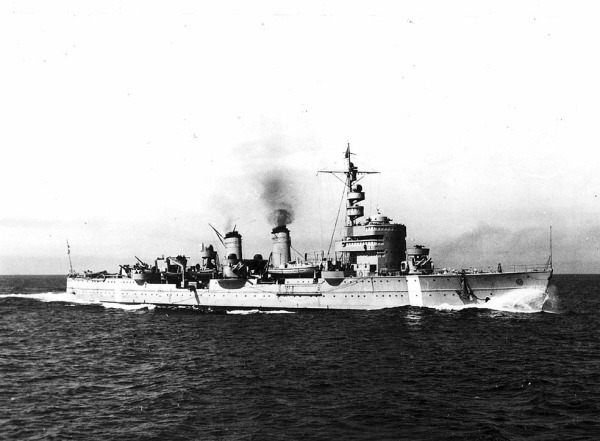
HSwMS Fylgia underway during ww2, showing her neutrality bands.
Nevertheless, pressure was greatly relieved when Germany attacked USSR, the traditional enemy. Despite internal and extrernal pressure to join the axis, Sweden resisted any policy of collaboration, and was never part of the “great crusade against Bolshevism”. From 1943 until 1947, its rearmament plan went on uninterrupted, making the fleet still relevant during the cold war, a serious threat for the Soviet Navy.
However the three-crowns Kingdom’s neutrality orientation remains controversial, and its ambiguous attitudes have long led the British to believe that the latter leaned to the Axis side. Opposed to USSR, de facto allied to the British and Americans, Sweden indeed had more sympathy for the Finns fighting the Russians from 1939, while opposing at the same time the Franco-British attempt to cross its territory to help the Finns. The fleet during the conflict had clear objectives, to ensure the safe passage of its trade fleet through the Baltic and the North Sea. Up to the very last days of the war, Sweden never took a side.
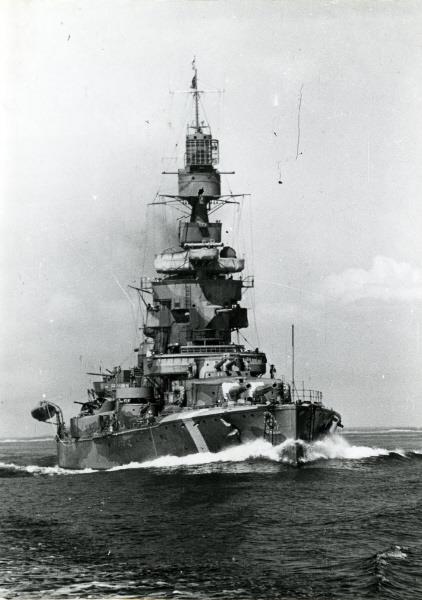
The HSwMS Sverige in WW2, showing an extensive camouflage and a heavy cruiser battery (8 in guns). It looks menacing, intimidating and towering, and on paper can resist the fire of heavy cruisers. They would have dealt with any Kreisgmarine of Soviet Navy ships except for Russian dreadnoughts, German Pocket Battleships or the Scharnhorst class. But in any case aviation would have been likely their main adversary.
The state of the Swedish Fleet in 1939
In 1939, Sweden was counting on a handful of armored coastal “pocket battleships” dating back for the most recent, of the 1920s, and WW1 to prior the war for the others, and a large fleet of torpedo boats, and destroyers. Some of these destroyers were of Italian origin, as well as the few modern torpedo boats. There was however only a single light cruiser of low tonnage for reconnaissance. More than half of the fleet was dating back from the Great War or early 1920s.
Sweden however was known for its expertise in medium automated cannons, like the famous Bofors 40 mm anti-aircraft gun, produced massively under licence by UK in 1938 and he US in 1940, and deployed on all allied ships. In 1945, the Swedish fleet tonnage tonnage had doubled, the rejuvenation was carried out. Throughout the war, the Swedish ships presented a camouflaged livery, well adapted to the many islands of its southern facade, and white neutrality bands painted in the front and the back of the hull for extra identification. Swedish ships names were prefixed HMS, like British ones, standing for but the longer form is often used to avoid confusion, HSwMS.
Swedish “Battleships”
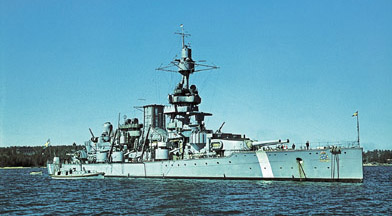
HSwMS Sverige – colorized photo in ww2
Having no intention of ordering a dreadnought before WW1 nor a faster battleship afterwards, Sweden relied only on its armored coastal “battleships”, which main artillery and protection was a far cry from Western or Russian battleships. Nevertheless, there was neither the will or budget to underwent the contruction of any “sea going battleship” as a defensive policy made it unnecessary. The only blueprints we have concerns only coastal battleships (see below).
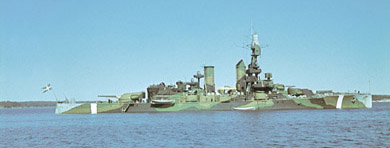
A rare photo of WW2 showing the green camouflage of Drottning Victoria
-9 Armored Coastal Batleships:
Although this workforce included old vessels, slow, their military value was intact, and they had been modernized. These were the Three Sverige class (commissioned in 1919-20), HSwMS Oscar II (1905), the four Äran class (1901-03), and the HSwMS Dristigheten (1900). The Niord of 1898 was certainly the oldest of all, but she was relegated to secondary roles and not really fit for service in WW2. These coastal battleships were all armed with heavy guns, protected by full armor, belts, citadels, conning towers, protective deck, and equipped with a substantial AA, including the Bofors. Although without radars and using old sights and ballistic computers with non-existent ASW defense these ships were certainly ot invulnerable. They were classified in three types according to their importance (1Kl, 2Kl and 3Kl Pansarbataar). Although impressive to look at they were a far cry from the read deal: Monsters such as the Bismarck dwarfed them (8,500 tons against 50,000).
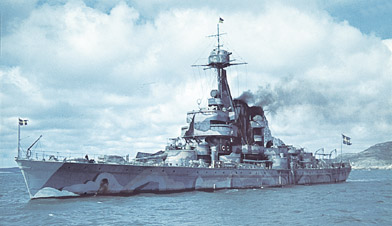
HSwMS Manligethen
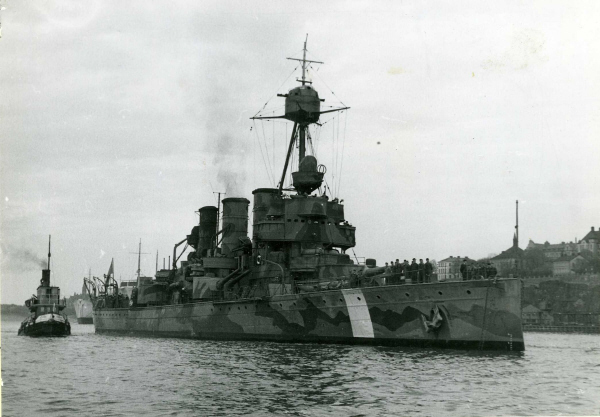
HSwMS Oscar II
Coastal Battleship projects:
Several designs of a more modern coastal battleship were studied, such as one some sources refer to as:
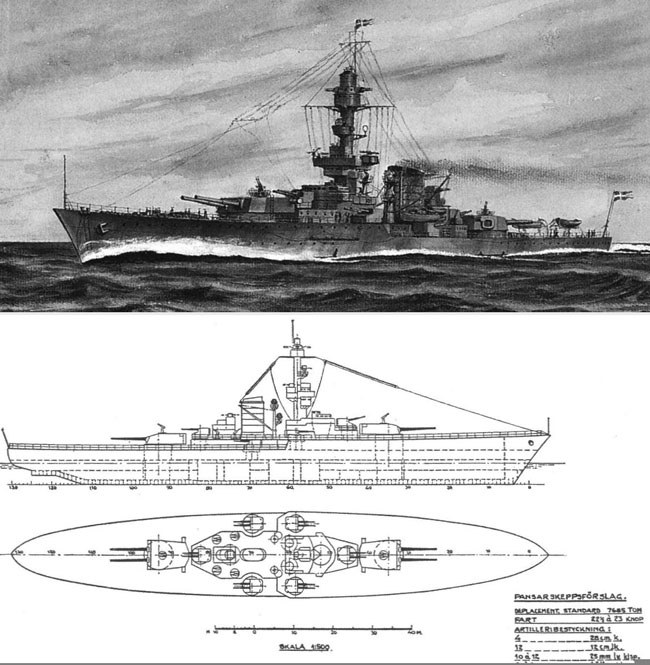
> “Viking class” (1934/36): Dimensions: 133m x 19,5m x 6,85m, Displacement: 7.150tons standard, Populsion: 20.000shp, 4 shafts, 22 knots, protected by a belt 254mm thick and 50 mm decks, four 254mm Guns (2×2) and 2×3 120m DP-AA Guns, 4×2 40m AA Guns.
> Ansaldo Project 1 (1941): 173 m x 20m x 7m and 17.000 tons standard, propelled by 90.000shp on 4 shafts, and a top speed of 23 knots, protected by a belt of 200 mm, Decks of 120 mm and armed with six (3×2) 280 mm, 4×2 120 DP, 5×2 57 AA, 2×2 40 AA, 6x 20 mm AA Guns. The latter could have been in effect too large and costly for Sweden’s needs.
> Ansaldo Project 2 (1945): Displacement of 13.900 tons (unknown dimensions), propelled by 56.000 shp on 2 shafts, top speed of 37 km/h or 20 knots, protected by a 300 mm belt and 120 mm deck. Armed with 2×3 210 mm, 2×2 120mm DP, 6×2 57mm and 16×1 25mm AA Guns.
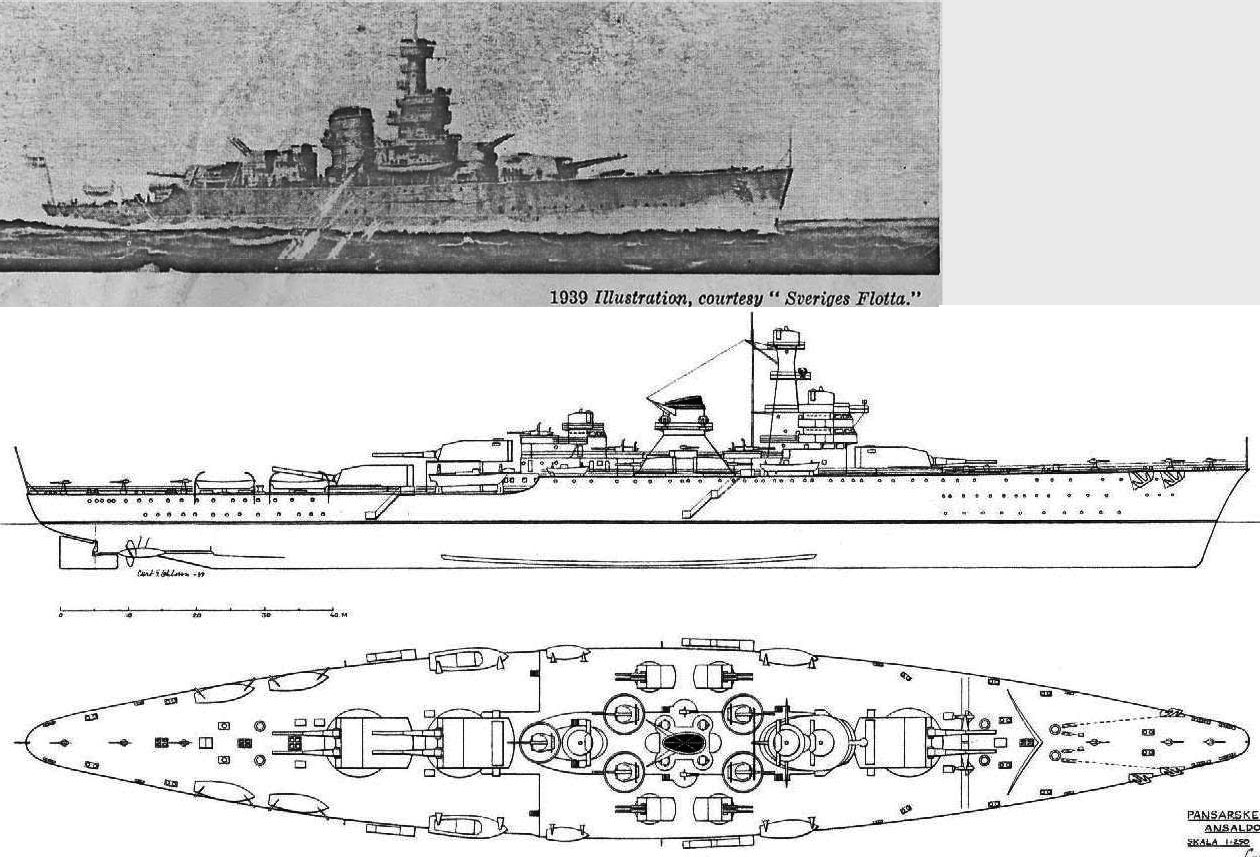
The link between Italian designers and the Swedish Navy made the yard delivering two designs intended for Sweden but non was acted, probably seen as too ambitious for the avilable budget.
Two Swedish Cruisers (1939)
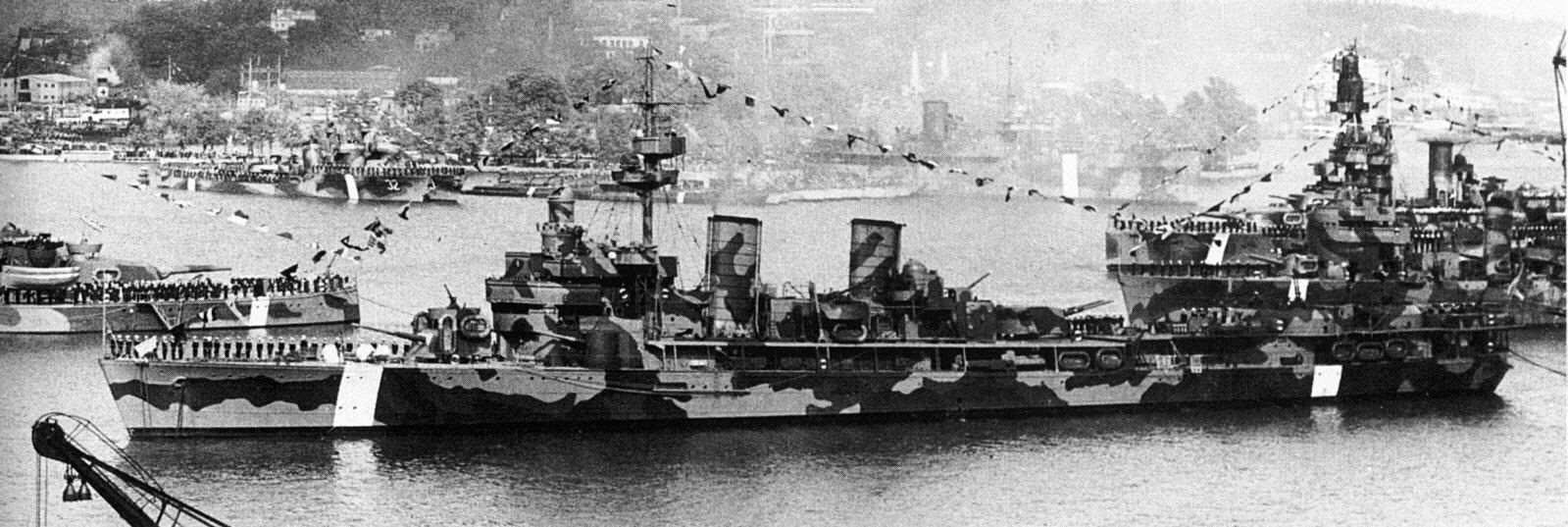
The floatplane-carrier/Cruiser HSwMS Gotland, one of th e interesting cruiser designs of the 1930s, here in WW2 with the rest of the fleet (Credits kbismarck.dk)
In this respect, there was only one true modern ship, Gotland (1933). At her side, the armored cruiser Fylgia (1905) was the smallest cruiser of this kind in WW2. The latter was in dry dock to be radically modernized in 1939-40. On the other hand, she asked for blueprints to Ansaldo, to built on her specifications two modern cruisers, the Tre Kronor class, started in 1943. They were launched in 1944-45 and completed in 1947, therefore they are studied here.
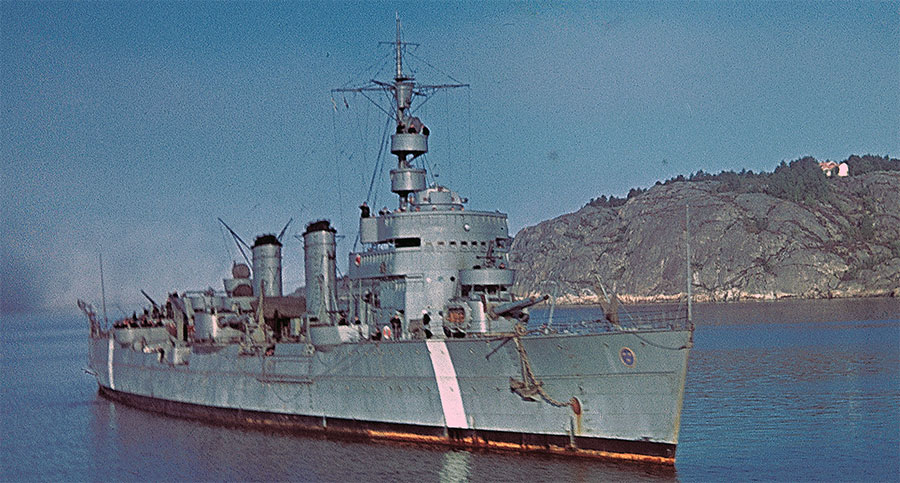
Colorized photo of the HMS Fylgia circa 1941. Src
-20 Destroyers:
There were two categories of desotryers according to their age: Those of the WW1 generation: Magne, Sigurd, Hugin and Wrangel classes. They had been modernized during the interwar but were of limited military value, rather comparable to torpedo boats. In all 9 ships.
The interwar destroyers, Ehrensköld and Psilander (Italian-built, Sella type), Klas Horn and Romulus (Italian-built), and Gothenburg class. This represented 8 units in all, while 3 others were in completion when WW2 broke out. Three new classes would be started during the war: Mode class (4 units, launched 1942), Visby class (4 units, 1942-43), and Öland class (2 units, launched 1945). Balance was 20 destroyers in 1939, 10 more during the war, 30 in total, which made Sweden by far the strongest of the “gree water navies” in existence during the 1940s.
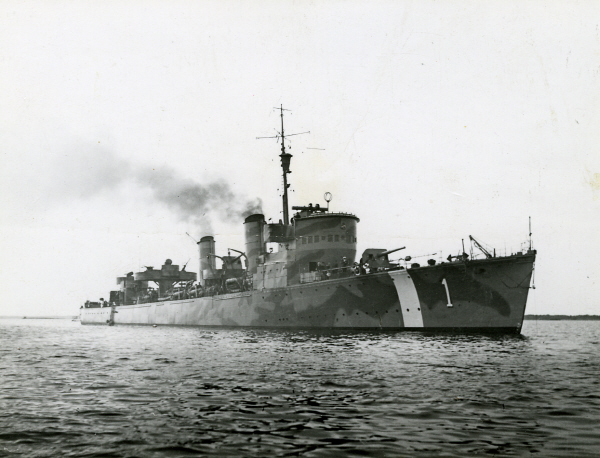
HSwMS Ehrensköld, the last prewar class of Swedish destroyers
-34 Torpedo boats:
In 1918 the Swedish Navy had 29 so-called “first class” coastal torpedo boats, dating from 1896 to 1910. In 1928, they were reclassified as patrol boats and re-registered V27 to 50. Some were dropped from the lists and 24 were all of which formed this line of defense in 1939. They were gradually erased from the lists during the war, and all after 1947. It also lined up with them 10 so-called “second class” torpedo boats, weighing 60 tons as standard.
-16 Submersibles:
The numbers included the Hajen (1917), Bävern (1921), Draken (1926-30), the Valen (1925), the Delfinen (1934), Sjölejonet (1936-41) being partly under construction, the Neptun ( 1942), and U1 (1941-44) being put into service during the conflict. Balance: 16 in 1939, 15 others during the war.
-16 Patrol ships:
In 1939, sweden aligned a small number of multirole patrolmen, apart from its torpedo boats. It will also build during the conflict. The oldest were of the Styrbjörn class (1923-25), bought from Norway in 1935-36 on the model of whalers, but also the Asköfjärd (1931-32) and Edöfjärd (1933), light, the Jägaren (1932- 34), more important, altogether 16, and during the war the SKV1 (1944), and V51 (1944-45), or 11 units.
-9 Minelayers:
There were two units, one built in 1912 and modernized, the cruiser Clas Fleming, and another specially designed in 1942-44, the Ävsnabben. In 1939, the Swedish Navy also accepted the Mul10, a 166 ton coastal mine smelter. Others much older were still in use, the Mul3,5,6,7,8 and 9, the first dating back to the late nineteenth century. Some torpedo boats could also perform this role, as well as the destroyers. Minefields were an effective and inexpensive defense for a modest fleet.
-14 Minesweepers:
The fleet consisted of six old buildings (1917-18) of the Spängaren class, and eight of the Arholma class out of 14 (1937-40), the latter entering service in the course of 1941; but also smaller units, the M1 (1937) and M3-M26 during the conflict (1940-41). For the latter, it was 23 units
-26 Miscellaneous:
The Swedish Navy also had two training ships, former 1896-98 cruisers, the Jacob Bägge and the örnen, an aviso, the Svensksund (1891), which was modernized and became a surveillance vessel in 1942. She opened her way to the far north thanks to icebreakers Atle (1925) and Ymer (1932). In addition, she began to take an interest in torpedo launches. In 1939, she had two, the MTB3 and 4, design dating back to the Great War although built at Thornycroft in 1925. In August 1940, they were removed from service. Two others replaced them in 1940, ordered from Vosper, while she received 4 from Italy, T11-14 ex-MAS 506, 508, 511 and 524 from Baglietto. In 1941, she built the T15 to 18 on a very close design, and in 1942-43 ten others a little larger (T21-31).
Total 1939: 2 cruisers, 20 destroyers, 34 TBs, 16 Subs., and 26 misc. ships.
Total construction WW2: 2 cruisers, 10 destroyers, 10 subs., 38 misc. ships.
Read More
Conway’s all the worlds fighting ships 1906-1921
Conway’s all the worlds fighting ships 1922-1947
www.tornsvala.se/2017/08/14/pansarskepp-sverige-klass-del-4/
www.avalanchepress.com/IronSwedes1.php
siknasfortet.se/en/history/
en.wikipedia.org/wiki/Sweden_during_World_War_II
en.wikipedia.org/wiki/Military_equipment_of_Sweden_during_World_War_II
Nomenclature of the Swedish Fleet
Coastal Battleships
Gustav V class (1915)
Gustav V, Sverige, Drottning Victoria, launched in 1915-18 completed in 1919-21, modernized in 1930-38. Their appearance varied according to their chimneys: those of Drottning Victoria remained in place (2), those of Gustav V were truncated in one, as well as those of Sverige. They will be withdrawn from service in 1953-57.

Length/Width: 110×20 meters, Displacement 7900 tons standard, 8500 TFL
2 shaft turbines, 8 boilers, 50,000 hp, 26 knots
Maximum shielding: 225-250 mm
Weaponry: 4×305, 6×152 mm, 8×40 mm AA, 8×20 mm AA.
Crew: 750
 Oscar II (1905)
Oscar II (1905)
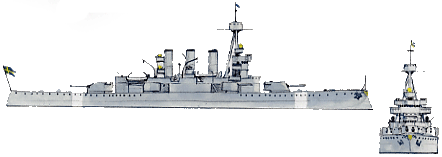
Launched in 1905, completed in 1907, modernized in 1939. She was used in 1940 as a training ship, but actively operational for coastal defense. She will be discarded in 1950.
Dims: Length/Width: 95×16 meters, Displacement 3800 tons standard, 4300 sq.ft.
Prop: 2 shafts turbines, 8 boilers, 30,000 hp for 23 knots in operation
Maximum shielding: 225-250 mm
Weaponry: 4×203, 8×152, 4×40, 4×20 mm AA.
Crew: 600
 Äran class (1901)
Äran class (1901)
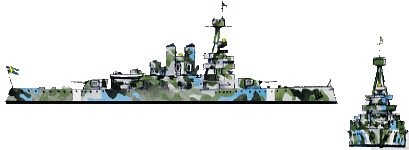
Äran, Wasa, Manligheten, Tapperheten, launched in 1901-03 completed in 1904-06, modernized in 1939, 40 and 41. The Wasa was removed from the lists in 1940 but was rebuilt in fake Gustav V in order to deceive the intelligence services of axis.
Dims: Length/Width: 85×16 meters, Displacement 3800 tons standard, 4200 sq.ft.
Peop: 2 shafts turbines, 8 boilers, 25,000 hp for 22 knots in operation
Maximum shielding: 225-250 mm,
Weaponry: 4×203, 6×152, 4×40, 4×20 mm AA.
Crew: 350.
 Dristigheten (1900, converted 1927)
Dristigheten (1900, converted 1927)
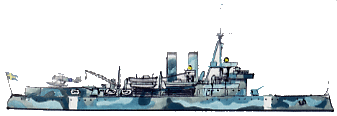
Launched in 1900 and completed in 1902, modernized in 1927, she was rebuilt as a seaplane support ship. She was removed for the lists in 1947.
Length/Width: 85×16 meters, Displacement 3700 tons standard, 4000 tons FL
2 shaft turbines, 4 boilers, 15,000 hp for 16 knots in operation
Maximum shielding 225-250 mm
Weaponry (as converted) 4×75 mm, 2×25 mm AA.
Crew 300.
Cruisers
 Fylgia class (1905)
Fylgia class (1905)
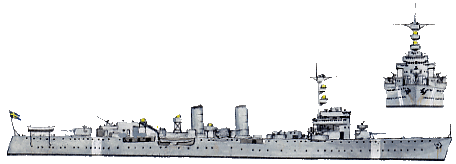
Launched in 1905 and completed in 1907, she was modernized in 1939-40. popularly known as the “White Swan of Sweden”, she was for a long time the smallest and last armoured cruisers ever built, and the best protected cruiser in the Baltic Sea. Her armament was however totally unsuited for duelling with German or Soviet cruisers, but she could count on an exceptional strenght. She served as a school ship until discarded in 1953.
Length/Width: 85 x 14 meters, Displacement 4310 standard tons, 4500 sq.ft.
2 shafts turbines, 6 boilers, 25,000 hp for 26 knots in operation
Maximum shielding 140-80 mm
Armament 2×152, 6×120, 8×40, 8×20 mm AA.
Crew 400.
 Götland (1933)
Götland (1933)

Launched in 1933 and completed in 1935. HSwMS Gotland was the first of her kind and was visited by naval experts worldwide as testing this concept of hybrid aircraft carrier/cruiser. Her 6 usual aircraft (10 stowable on deck and 2 in the hangar) were Hawker Ospreys.
In May 1941, Götland participated in an important event related to the Bismarck. She saw the German battleship, with cruiser Prinz Eugen and destroyers trying to reach the North Sea by passing through the Kattegat. She signalled […] “At 12:00, 20 miles West of [the island of] Vinga. 5 [escort vessels], followed at 10 miles distance by 3 [destroyers] + 1 cruiser + 1 larger ship (Bismarck?). 10-12 aircraft are circling the ships. Course North +.”
HSwMS Götland was by then engaged in a routine exercise, and immediately proceeded to shadow the German flotilla for several hours.
This message was sent to Swedish Navy HQ and report found its way to British naval officials in Sweden, of course prompted to the Royal Navy. This was the start of the legendary hunt for the Bismarck. Obsolete by 1943, the Fairey biplanes were removed and the ship was converted into an anti-aircraft cruiser with eight 40 mm Bofors and sixteen 25 mm AA. Her artillery was singular, with a single twin 6-in (152 mm) turret and two more for lack of space converted into two side “barbettes”. She was modernized again in 1954 and retired from service in 1960.
Length/Width: 134,8×15,40 meters, Displacement 4,700 standard tons, 5550 FL
2 shaft Laval turbines, 4 Penhoët boilers, 33,000 hp for 28 knots in operation
Maximum shielding 51 mm
Weaponry: 6×152, 4×75, 4×25, 4×8 mm AA, 6 TLT 533 mm, 80-100 mines, 6 aircraft.
Crew: 467.
 Tre Kronor class (1943)
Tre Kronor class (1943)

(“Three Crowns”), launched in 1945, completed in 1947, with the Göta Lejon. Undoubtedly the best Swedish cruisers ever produced, and the last, they did not have time to be operational before the end of the conflict. Their 152 pieces were divided into two double turrets (on the back) and one triple (on the front). The DCA was exclusively composed of these excellent 40 mm Bofors. In 1950 the Göta lejon was modernized and rebuilt, then sold in Chile in 1971, which still used it until the 90s. The second was withdrawn from service in 1964.
Dims: Length/Width: 182×16.70 meters, Displacement 8200 tons standard, 9200 tons FL.
Prop: 4 shaft Laval turbines, 4 boilers, 90,000 hp for 33 knots max
Maximum shielding: 130-100 mm
Weaponry: 7×152, 27×40 mm Bofors AA, 6 TLT 533 mm, 160 mines
Crew: 610
Destroyers
 Ehrenskjöld class (1926):
Ehrenskjöld class (1926):
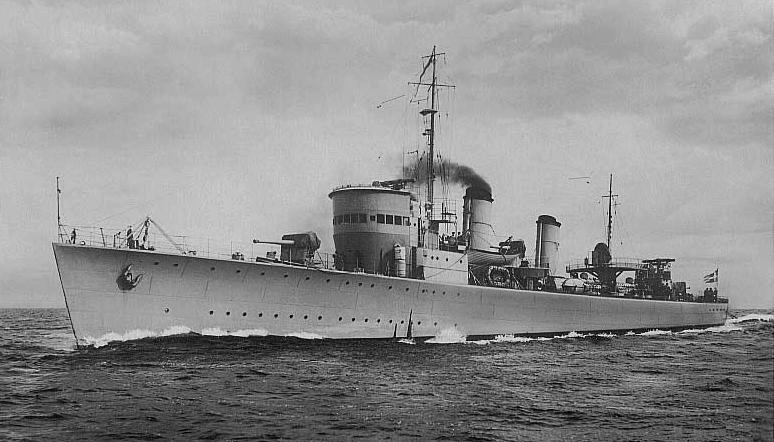
Two ships Launched in 1926 and completed in 1927. With her sister ship HSwMS Nordenskjöld, she made the Ehrensköld class, first interwar Swedish-built class of destroyers, and both in size and speed, was quite an upgrade in the Swedish inventory. Ehrensköld’s pennant changed from 11 to 1. Nordenskjöld had the pennant 12. This class brings on the table two major improvements: Three 12 cm guns and new stadard 53 cm torpedo. As a reminder, the last destroyer class built wy Sweden prior was the Wrangel class (launched 1917). These were 498 tonnes boats, 70 m long, armed with four 75 mm (3 in)/49 cal. M/12 guns and two twin banks of 457 mm torpedo tubes (18 in).
Design
So with almost twice the displacement and heavy guns, the Swedish destroyers placed themselves in the the standards of the time, whereas previous classes were little more than glorified torpedo boats tailored for the coastal fleet. By that time indeed, in 1924, the Swedish Navy operated 10 destroyers and 29 first-class torpedo boats. The destroyers were absolutely not comparable to those of two potential adversaries, the Royal Navy and the Soviet Navy. Therefore the admiralty requested a new design which was inspired by many contemporary ships and ended with the Ehrenskjöld class, which blueprints were approved in 1924 and construction started at Kockums, Malmö and Götaverken, Gothenburg. Both ships were launched in June and December 1926 and completed in 1927.
Armament
Their strong points were three 120 mm (4.7 in) guns built by Bofors, on single mounts. They were all in the axis for best broadside, one forward, one aft and one between the two funnels. Crucially, the hull had no forecastle as it was flush-dsck, which recalled USN destroyers both in general appearance and armament. The was also from the start a consequent Anti-aircraft armament with two Vickers 40 mm automatic AA guns. The two triple torpedo mounts fired 53 cm (21 in) torpedoes. They were placed in the axis behind the aft funnel. Also the ships were fitted with rails for minelaying, long enough for 20 mines.
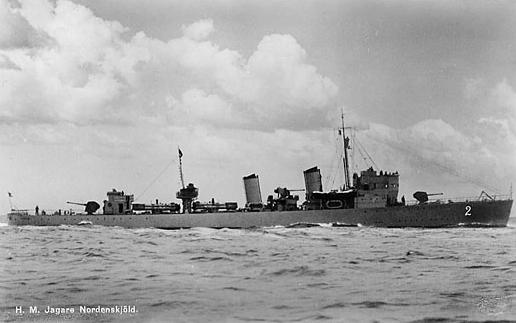
HMS Nordenskjöld
Propulsion
Propulsion-side, they were fitted with three Penhoët boilers, which fed two de Laval geared steam turbines. Total output was 34,000 shaft horsepower (25,000 kW) which allowed a top speed of 36 knots (67 km/h; 41 mph), to compare with the 34 knots of the previous class (in calm weather). Their range was 1,600 nmi (1,800 mi; 3,000 km) at 16 kn (18 mph; 30 km/h).
Active service
The lead destroyer was named after the admiral Nils Ehrenschiöld and had the full name but the first was removed one year after her launch.
In the summer of 1929 she escorted HSwMS Sverige to Estonia and Latvia with King Gustaf V on board for a state visit. He visited Tallinn and then Riga. In 1930, they escorted the ship for another international state visit, with HSwMS Gustav V and HSwMS Drottning Victoria. They stopped at Swinemünde to collect the dust from Queen Victoria which died in Rome. In 1934 Ehrensköld ran aground on her way to Stockholm, and the hull was flooded. However thanks to a powerful reverse manoeuver she landed on a shoal and after smmary repairs, made it to Stockholm’s naval shipyards.
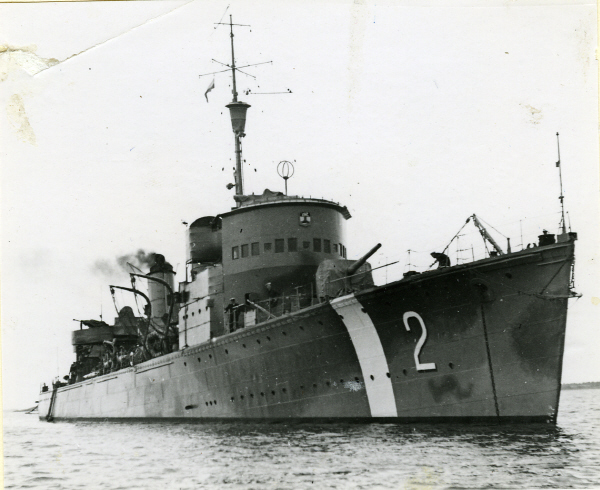
Nordenskjöld in ww2, notice the neutrality white bands.
In September 1938 (Invasion of Czechoslovakia) Ehrensköld and HSwMS Klas Horn were mobilized to patrol Swedish waters. In April 1940, she was demobilized in Karlskrona, but the crew was assembled and after exercises she returned into service on 2 September 1940. She was part of the Karlskrona Squadron, South Coast Naval District. In 1942 she joined the Coastal Fleet for a time and returned to the Karlskrona Squadron. Her AAA changed, with the addition of two twin 25 mm guns.
In 1951-1952 both ships were converted to frigates. Their torpedo armament was removed, as the aft gun and four 40 mm automatic guns m/36 were installed. At last a modern hydrophone was installed and depth charges thrower for ASW warfare. There was also a modern command center with radar. As such, both ships served until decommissioned on 1 April 1963, and were used as target ship until 1973, when they were sold and scrapped. That was quite a career.
Ehrenskjöld class Specifications |
|
| Dimensions | 89 x8.88 x3.80 m (292 x 29 x 12 ft) |
| Displacement | 974 tonnes standard, 990 short tons |
| Crew | 120 |
| Propulsion | 2 shaft De Laval GS turbines, 3 Penhoët boilers, 34,400 shp |
| Speed | 36 kn (41 mph; 67 km/h) |
| Range | 1,600 nmi (1,800 mi; 3,000 km) at 16 kn |
| Armament | 3x 120 mm, 2 Vickers 2-pdr AA, 2×3 53cm TTs |
 Psilander Class (1926):
Psilander Class (1926):
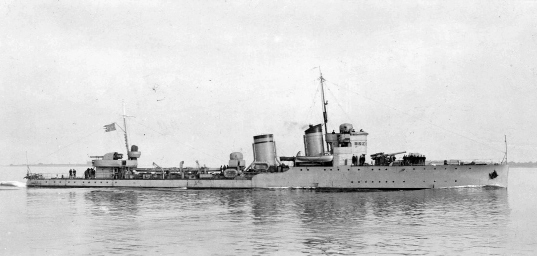
2 Launched in 1926 and completed in 1927. Ex-Italian Nicotera and Ricasoli. Built in Naples, of the Sella class, sold and transferred in March 1940. Detained for a month in the UK (also in order to study them), then transferred to Sweden. Not fit for the Baltic.
Length/width: 84 x 8.6 meters, Displacement 1250 standard tons.
2 shaft Parsons turbines, 3 Thornycroft boilers, 36,000 hp for 35 knots in operation.
Armament 4 x 120, 2 x 40 mm AA, 2 x 13.2 mm AA, 4 TLT 533 mm, 10 mines.
Crew 106.
 Klas Horn Class (1932):
Klas Horn Class (1932):
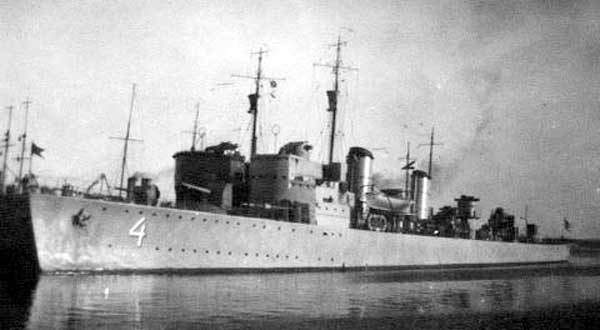
Two Launched in 1931 and completed in 1932. Close to the Ehrenskjöld but larger. On September 17, 1941 they were sunk by a huge accidental explosion of unexplained origin, which also sank the destroyer Gothenburg. In fact, the most damaged (Klas Ugla) was cannibalized to repair the Klas Horn, which was equipped with six 25mm AA guns.
Length/width: 91×8.9 meters, displacement 1020 standard tons.
2 shaft Laval turbines, 3 Penhoët boilers, 34,000 hp for 36 knots in operation.
Armament 3×120, 2x40mm AA, 6 TLT 533mm, 2 ASM mortars and 20 mines.
Crew 130.
 Göteborg Class (1935):
Göteborg Class (1935):
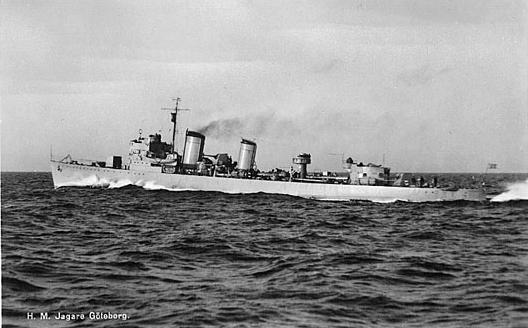
6 Launched in 1935-40 and completed in 1936-41. Close to the Ehrenskjöld but much bigger. Powerful and very fast (41 knots at the trials). The Gothenburg was sunk during an accidental but repaired explosion.
Length/width: 94.6 x 9 meters, displacement 1040 standard tons.
2 propellers, 2 Laval turbines, 3 Penhoët boilers, 32,000 hp for 39 knots in operation.
Weapon 3 x 120, 6 x 25 mm AA, 2 mitt. 13.2 mm AA, 6 TLT 533 mm, 2 ASM mortars and 20 mines.
Crew 135.
 Visby Class (1942):
Visby Class (1942):
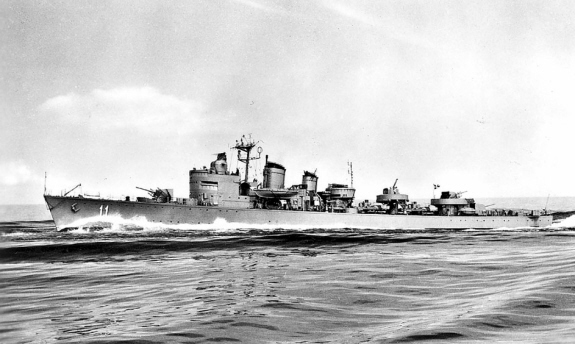
Four Swedish fleet destroyers Launched in 1942-43 and completed in 1942-44. Of the Göteborg type, but larger and with a better AA and ASW armament.
Length/width: 98 x 9 meters, Displacement 1135 standard tons.
2 shaft Laval turbines, 3 boilers at Triple Exp., 36,000 hp for 39 knots in operation.
Armament 3 x 120, 4 x 40 mm AA, 3 x 20 mm AA, 6 TLT 533 mm, 4 ASM mortars and 20 mines.
Crew 140.
 Öland class (1944):
Öland class (1944):
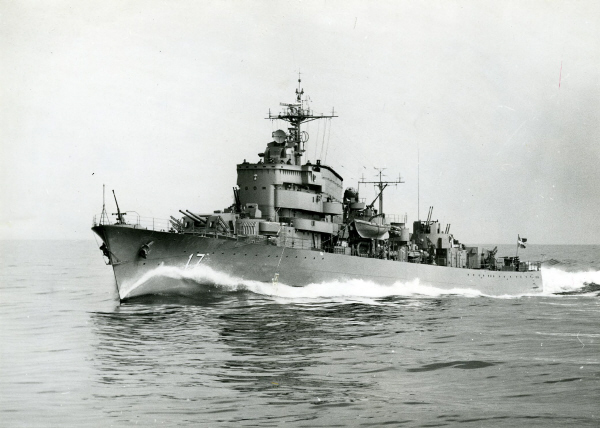
Two Swedish fleet destroyers Launched in 1945-46 and completed in 1947-48. Much larger, inspired by the USN Gearing class.
Length/Width: 112 x 11.2 meters, Displacement 1880 standard tons.
2 shaft Laval turbines, 2 Penhoet boilers, 44,000 hp for 35 knots in operation.
Armament 4 x 120, 6 of 40 mm AA, 8 x 25 mm AA, 6 TLT 533 mm, 1 LR Bofors 375 mm ASM and 60 mines.
Crew 210.
Coastal destroyers
 Romulus class (1934):
Romulus class (1934):
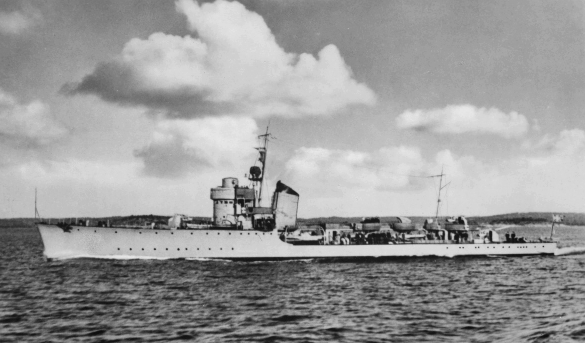
Two Italian-built TBs Launched in 1934 and completed in 1935. Torpedo boats of the Spica class, transferred in March 1940, and detained in the Faroe Islands for a month by the Royal Navy. Modified for the winter conditions of the Baltic.
Length/width: 81.40 x 7.9 meters, Displacement 870 standard tons.
2 propellers, 2 Tosi turbines, 2 boilers, 19,000 hp for 34 knots in operation.
Armament 3 x 100, 3 x 20 mm AA, 4 TLT 450 mm, 2 ASM mortars and 18 mines.
Crew 100.
 Mode Class (1942):
Mode Class (1942):

4 Launched in 1942 and completed in 1942-43. Classified as coastal destroyers, with reduced range and speed and a single TLT bench.
Length/Width: 78 x 8 meters, Displacement 750 tons standard.
2 shaft Laval turbines, 2 boilers triple exp., 16,000 hp for 30 knots in operation.
Armament 3 x 105, 6 x 40 mm AA, 2 of 20 mm AA, 3 TLT 533 mm, 2 ASM mortars and 16 mines.
Crew 100.
2nd class Destroyers
 Magne Class (1905):
Magne Class (1905):
2 Launched in 1905-07 and completed in 1906-08
Length/width: 65 x 8 meters, Displacement 460 standard tons
2 shaft Laval turbines, 3 Triple Exp. Boilers, 5,000 hp for 22 knots in operation
Armament: 3 x 100, 4 x 40 mm AA, 3 x 20 mm AA, 6 TLT 533 mm, 4 ASM mortars and 20 mines
Crew: 80
 Sigurd class (1908):
Sigurd class (1908):
3 Launched in 1908-09 and completed in 1909-10.
Length/width: 67 x 8 meters, Displacement 462 standard tons.
2 propellers, 2 Laval turbines, 3 Triple Exp. Boilers, 5,000 hp for 22 knots in operation.
Armament 3 x 100, 4 x 40 mm AA, 3 x 20 mm AA, 6 TLT 533 mm, 4 ASM mortars and 20 mines.
Crew 80.
 Hugin Class (1910):
Hugin Class (1910):
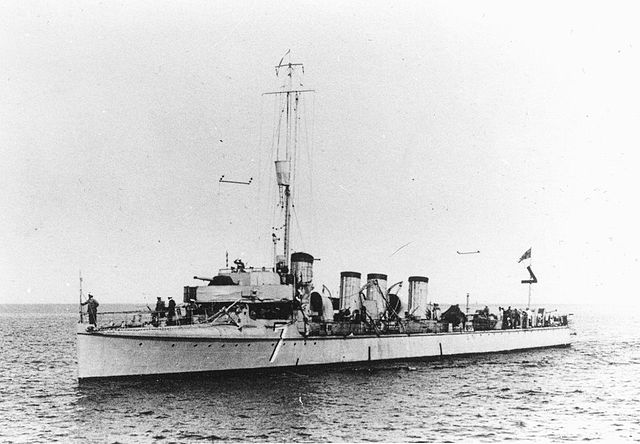
2 Launched in 1910-11 and completed in 1911-12.
Length/width: 67 x 8 meters, Displacement 460 standard tons.
2 propellers, 2 Laval turbines, 3 Triple Exp. Boilers, 5,000 hp for 22 knots in operation.
Armament 3 x 100, 4 x 40 mm AA, 3 x 20 mm AA, 6 TLT 533 mm, 4 ASM mortars and 20 mines.
Crew 80.
 Wrangel Class (1917):
Wrangel Class (1917):
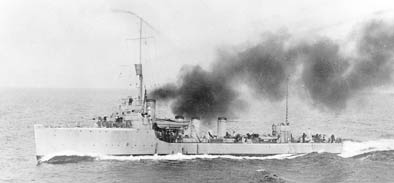
2 Launched in 1917 and completed in 1918.
Length/width: 72 x 8 meters, Displacement 498 standard tons.
2 propellers, 2 Laval turbines, 3 Triple Exp. Boilers, 5,000 hp for 22 knots in operation.
Armament 3 x 100, 4 x 40 mm AA, 3 x 20 mm AA, 6 TLT 533 mm, 4 ASM mortars and 20 mines.
Crew 80.
Swedish Torpedo Boats
 Plejad Class (1905):
Plejad Class (1905):
17 Launched in 1905-10 and completed in 1906-11. Built by the French Normand shipyard. In 1928 the TLT will be removed. Four will be struck off lists in 1940, two in 1941, two in 1944.
Length / width: 38 x 4.5 meters, displacement 106-120 tons standard.
2 propellers, 2 Normand turbines, 3 Normand boilers, 2600 hp for 21 knots in operation.
Weapon 2 x 100, 1 x 20 mm AA,
Crew 31.
 Komet class (1896):
Komet class (1896):
12 Launched in 1896-1903 and completed in 1897-1904. Built by the German shipyard Schichau. In 1921 TLTs will be removed when they are reclassified as patrollers. 7 were in service in 1939, Three will be deleted from the lists in 1941, 42 and 1943. The others in 1947.
Length / width: 36 x 4.2 meters, displacement 96-104 standard tons.
2 propellers, 2 Schichau turbines, 3 standard boilers, 1800 hp for 21 knots in operation.
Weapon 2 x 100, 1 x 20 mm AA,
Crew 31.
 Class N°5 (1906):
Class N°5 (1906):
10 Launched in 1906-08 and completed in 1907-09. In 1928 the TLT will be removed (patrollers). One, the No. 6, will be cast in 1944 (error). They served in the body of the coastal artillery.
Length/Width: 27 x 3.10 meters, Displacement 60 tons standard.
2 propellers, 2 Laval turbines, 2 Normand boilers, 160 hp for 16 knots in operation.
Weapon 2 x 100, 1 x 20 mm AA,
Crew 16.
Swedish Submersibles
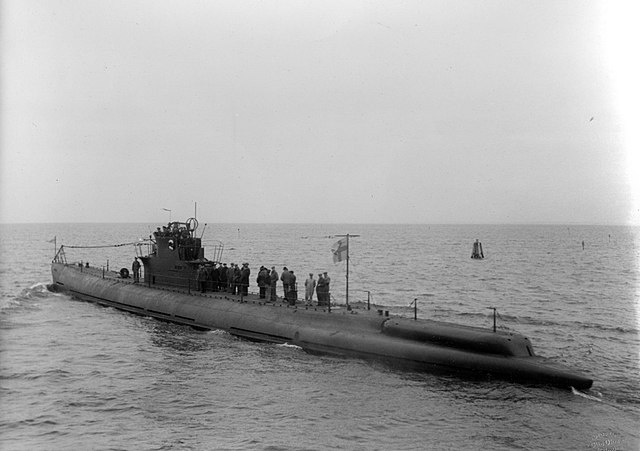
HSwMS Sjölejonet in 1936
 Hajen Class (1917):
Hajen Class (1917):
3 Launched in 1917-18. Striped lists in 1942-43.
Length / width: 38 x 5.5 meters, Displacement 422 standard tons.
2 propellers, 2 diesels, 2 mot. elect. 1600/800 hp for 12/6 knots in operations.
Weapon 1 x 75 mm, 4 TLT 533 mm
Crew 26.
 ävern class (1921):
ävern class (1921):
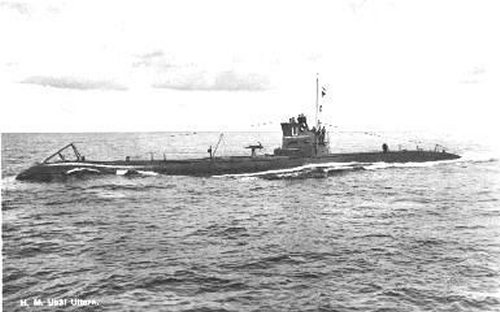
Uttern of the Bävern class.
3 Launched in 1921: Bävern, gggg, Uttern. Uttern suffered an accident in 1942 but was repaired. Discarded in 1944. The Valen for some sources was very close to the Bävern class.
Length/width: 39 x 5.8 meters, Displacement 472 standard tons.
2 propellers, 2 diesels, 2 mot. elect. 1600/800 hp for 13/7 knots in operations.
Weapon 1 x 75 mm, 4 TLT 533 mm
Crew 31.
 Draken class (1926):
Draken class (1926):
3 Launched in 1926, 28 and 30. The Ulven hit a German mine in 1943.
Length/width: 66.10 x 6.4 meters, displacement 667/850 standard tons.
2 shafts Götaverken diesels, 2 electric motors 1920/1000 hp, 13.8/8.3 knots.
Armament: 1 x 105 mm, 1 x 25 mm AA, 4 x 533 mm TTs
Crew: 35
 Valen (1925)
Valen (1925)
Launched in 1925. Minelayer submarine using the French Normand-Fenaux system. Stripped from the lists in 1943.
Length/width: 57.10 x 7.10 meters, displacement 548/730 standard tons.
2 shafts Götaverken diesels, 2 electric motors, 1340/700 hp for 14.8/7.4 knots in operations.
Armament: 1 x 75 mm, 1 x 25 mm AA gun, 4 TLT 450 mm, 20 mines.
Crew: 31
 Delfinen Class (1934):
Delfinen Class (1934):
3 Launched in 1934-35. Submersible minelayers.
Length/width: 63.10 x 6.4 meters, displacement 540/720 standard tons.
2 propellers, 2 MAN diesels, 2 mot. elect. 1200/800 hp for 15/9 knots.
Armament: 1 x 57 mm, 1 25 mm AA gun, 4 x 533 mm TTs, 20 mines.
Crew: 34
 Sjölejonet class (1936):
Sjölejonet class (1936):
9 Launched in 1936-41. 3 in service in september 1939. The fastest Swedish submersibles when they enter service.
Length/width: 64.20 x 6.4 meters, Displacement 580/760 standard tons.
2 shaft MAN diesels, 2 electruc motors 2100/1000 hp, 16.2/10 knotss.
Armament: 2 x 40 mm Bofors AA cannons, 6 x 533 mm TTs
Crew: 38
 Neptun class (1942):
Neptun class (1942):
3 Launched in 1942. Minelayer submersibles class: HSwMS
Length/Width: 62.60 x 6.4 meters, displacement 550/730 standard tons.
2 shaft 2 MAN diesels, 2 electri motors, 1800/1000 hp for 15/10 knots.
Armament: 1 x 40 mm AA Bofors, 1 x 20 mm AA, 5 x 533 mm TTs, 20 mines.
Crew: 35
 U1 class (1944):
U1 class (1944):
9 Launched in 1941-44. All in service before the end of the war. Coastal models called
Length/Width: 49.60 x 4.7 meters, Displacement 367/450 tons.
2 shafts, 1 MAN diesel, 2 electric motors, 1350/1000 hp for 13.8/7.5 knots.
Armament: 1 x 20 mm AA, 4 x 533 mm TTs
Crew: 23
Patrol Gunboats
 Styrbjörn Class (1923):
Styrbjörn Class (1923):
6 Launched in 1923-1925 and purchased in 1935-36. Armed whalers built by Norway.
Length/width: 37 x 7 meters, displacement 440 tons standard.
1 shaft TE steam engine, 800 hp, 10 knots.
Armament: 1 x 57, 1 x 37, mitt. 7.7 mm AA
Crew: 12
 Asköfjärd/Edöfjärd class (1931-33):
Asköfjärd/Edöfjärd class (1931-33):
6 Launched in two classes in 1931-1933. Auxiliary gunboats used as mobile coastal artillery.
Length/Width: 21.20 x 3.8 meters, Displacement 28 tons standard.
1 shaft diesel, 92 hp, 11.5 knots in operation.
Armament 1 x 37 mm
Crew: 7
 Jägaren class (1932):
Jägaren class (1932):

4 Launched in 1932-1934, fast and equipped for ASW warfare. The Guatemalan navy still uses one of them, purchased in 1960.
Length/Width: 52 x 6 meters, Displacement 310 tons standard.
2 propellers, 1 Laval turbine, 2 Vanson boilers, 3600 hp, 23 knots.
Armament: 2 x 75, 2 x 25 mm AA, 2 ASM mortars.
Crew: 41
 SKV1 class (1944):
SKV1 class (1944):
5 vessels Launched in 1944. Built by Larsson for Navy Volunteers.
Length/Width: 16.5 x 5.3 meters, Displacement 19 tons standard.
1 propeller, 1 diesel, 100 hp for 10.5 knots in operation.
Armament: 1 x 20 mm AA,
Crew: 7
 Class V51:
Class V51:
6 Launched in 1944-45. Built as auxiliaries of coastal artillery.
Length/Width: 32 x 5.3 meters, Displacement 145 tons standard.
1 shaft TE steam engine, 400 hp, 11 knots in operation.
Armament: 1 x 20 mm AA, 1 machine gun.
Crew: 12
Mine warfare vessels
 Clas Fleming (1912):
Clas Fleming (1912):
Cruiser Launched in 1912. Modernized in 1939-40 and completely rebuilt. Equipped for the first time with a revolutionary diesel system designed by Götaverken.
Length/width: 85 x 10.8 meters, Displacement 1750 standard tons.
2 shaft diesels, 5000 hp, 15 knots.
Armament: 4 of 152 mm, 2 of 75 mm and 21 of 40 mm, 2 x 25 mm AA, 200 mines.
Crew: 120
 Ävsnabben (1943):
Ävsnabben (1943):
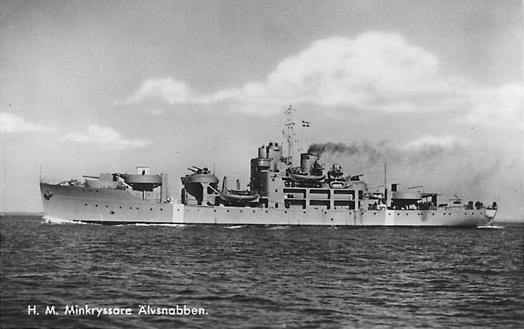
Launched in 1943. Armed and maintained in service until 1981. Also used as a training ship.
Length/width: 102 x 13.60 meters, Displacement 4250 standard tons.
1 propeller, 1 diesel, 3000 hp for 14 knots in operation.
Armament 4 of 152 mm, 8 of 40 mm and 6 of 20 mm, 200 mines.
Crew 255.
 Type Mul1 (1878):
Type Mul1 (1878):
Launched from 1878 to 1939. Modernized, very different from each others these were Coastal minelaying launches. It would took to much space to fill all the classes and single units of this type.
Length/Width: 27.4 x 5.6 meters, Displacement 166 tons standard.
1 shaft diesel, 200 hp, 9.5 knots.
Armament: 2 x 7.7 mm MG AA, 20 mines.
Crew: 8
 Spängaren class (1917):
Spängaren class (1917):
6 Launched in 1917-18. Modernized in 1936-38 and also used as supply vessels.
Length/Width: 42 x 6 meters, Displacement 185 tons standard.
1 shaft TE steam engine, 800 hp, 10 knots in operation.
Armament: 1 of 47 mm and 1 mitt. 7.7 mm AA.
Crew: 35
 Arholma (1937):
Arholma (1937):

14 Launched in 1937-40. Fast and well armed. Also used as patrollers.
Length/Width: 56.7 x 7.60 meters, Displacement 365 tons standard.
2 shaft Laval tubines, 2 boilers, 3200 hp, 17 knots.
Armament: 2 x 102 mm, 2 x 13.2 mm HMG AA, 2 ASW mortars, 20 mines.
Crew: 37
 Type M1 (1937):
Type M1 (1937):

2 Launched in 1937, Coastal patrol launches.
Length/width: 30 x 4.3 meters, displacement 61 tons standard.
3 shaft gasoline motors, 630 hp, 17 knots.
Armament: 1 x 20 mm AA.
Crew: 11
 Type M3/M15 (1940):
Type M3/M15 (1940):

11 Launched in 1940-1941, plus 11 others in 1941. Coastal vessels. The M3 are 50 tons, the M15 70 tons. Composite hull for the first, all-wooden for the second.
Length/Width: 25 x 5.10 meters, Displacement 60 tons standard
2 shaft diesels, 400 hp, 13 knots
Armament: 1 x 20 mm AA
Crew: 11
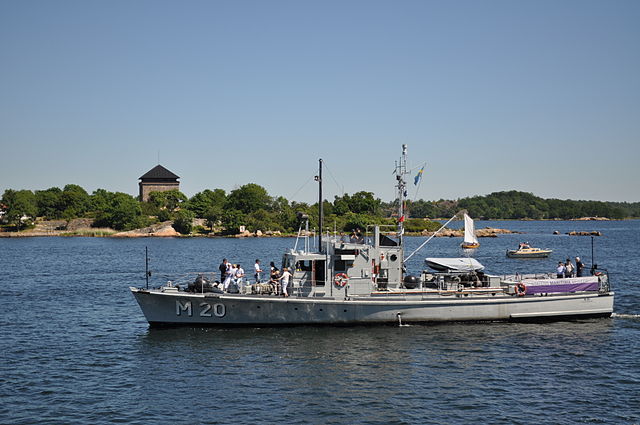
Miscellaneous ships
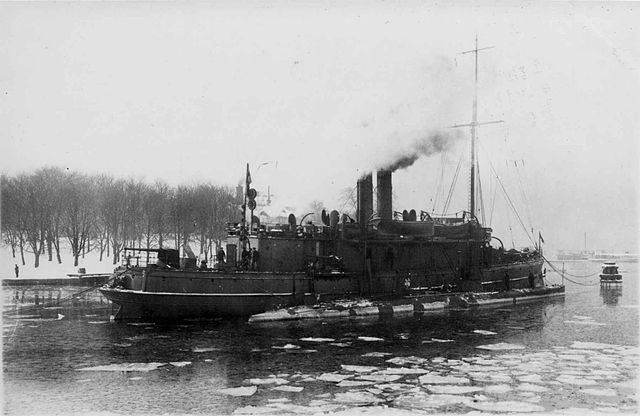
 Örnen class Tordedo Gunboats (1896):
Örnen class Tordedo Gunboats (1896):
Originally four Torpedo cruiser of 1896-99, ranging from 814 to 844 tons, used later as TB division leaders. Jacob Bagge became a seaplane tender 1225-35, and the next year as a cadet training ship. She survived until 1949, discarded, then BU in 1957. Örnen was a cadet training ship from 1920, discarded in 1950, sunk as target. Psilander was a cadet TS from 1928, sunk as target in August 1939 and Clas Horn was discarded and BU in 1924.
Svensksund: A 415 tons sloop of 1891, survey vessel in 1942, sticken in 1957.
Atle: Armed Icebeaker launched in 1925, 1725-2630 tons, 62.20 x 17 x 6.3m, 6000 hp, 14 knots, 5x 57 mm AA and 4 MGs, buolt at Lindholmen, Gothenburg, stricken 1966.
 Ymer (1932):
Ymer (1932):
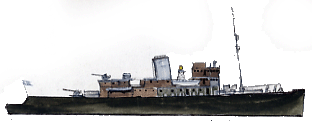
Launched in 1932. Built by Cockums, the world’s first diesel-electric icebreaker. She will serve until 1976.
Length/width: 78.60 x 19.30 meters, displacement 3465 standard tons
2 shafts, six diesel-electric units, 9000 hp, 15.9 knots
Armament: 4 x 75 mm, 2 x 40 mm AA, 4 x 25 mm AA
Crew: 44
 Type T11/15/21 (1943):
Type T11/15/21 (1943):
10 launched in 1942-43. The fastest motor torpedo boats in the world at that time.
Length/Width: 20 x 5 meters, Displacement 27 tons standard.
2 shaft Isotta-Fraschini, 3000 hp, 49 knots.
Armament: 2 x 533 mm TTs, 1 of 20 mm AA.
Crew: 11

 Latest Facebook Entry -
Latest Facebook Entry -  X(Tweeter) Naval Encyclopedia's deck archive
X(Tweeter) Naval Encyclopedia's deck archive Instagram (@navalencyc)
Instagram (@navalencyc)





 French Navy
French Navy Royal Navy
Royal Navy Russian Navy
Russian Navy Armada Espanola
Armada Espanola Austrian Navy
Austrian Navy K.u.K. Kriegsmarine
K.u.K. Kriegsmarine Dansk Marine
Dansk Marine Nautiko Hellenon
Nautiko Hellenon Koninklije Marine 1870
Koninklije Marine 1870 Marinha do Brasil
Marinha do Brasil Osmanlı Donanması
Osmanlı Donanması Marina Do Peru
Marina Do Peru Marinha do Portugal
Marinha do Portugal Regia Marina 1870
Regia Marina 1870 Nihhon Kaigun 1870
Nihhon Kaigun 1870 Preußische Marine 1870
Preußische Marine 1870 Russkiy Flot 1870
Russkiy Flot 1870 Svenska marinen
Svenska marinen Søværnet
Søværnet Union Navy
Union Navy Confederate Navy
Confederate Navy Armada de Argentina
Armada de Argentina Imperial Chinese Navy
Imperial Chinese Navy Marinha do Portugal
Marinha do Portugal Mexico
Mexico Kaiserliche Marine
Kaiserliche Marine 1898 US Navy
1898 US Navy Sovietskiy Flot
Sovietskiy Flot Royal Canadian Navy
Royal Canadian Navy Royal Australian Navy
Royal Australian Navy RNZN Fleet
RNZN Fleet Chinese Navy 1937
Chinese Navy 1937 Kriegsmarine
Kriegsmarine Chilean Navy
Chilean Navy Danish Navy
Danish Navy Finnish Navy
Finnish Navy Hellenic Navy
Hellenic Navy Polish Navy
Polish Navy Romanian Navy
Romanian Navy Turkish Navy
Turkish Navy Royal Yugoslav Navy
Royal Yugoslav Navy Royal Thai Navy
Royal Thai Navy Minor Navies
Minor Navies Albania
Albania Austria
Austria Belgium
Belgium Columbia
Columbia Costa Rica
Costa Rica Cuba
Cuba Czechoslovakia
Czechoslovakia Dominican Republic
Dominican Republic Haiti
Haiti Hungary
Hungary Honduras
Honduras Estonia
Estonia Iceland
Iceland Eire
Eire Equador
Equador Iran
Iran Iraq
Iraq Latvia
Latvia Liberia
Liberia Lithuania
Lithuania Mandchukuo
Mandchukuo Morocco
Morocco Nicaragua
Nicaragua Persia
Persia San Salvador
San Salvador Sarawak
Sarawak Uruguay
Uruguay Venezuela
Venezuela Zanzibar
Zanzibar Warsaw Pact Navies
Warsaw Pact Navies Bulgaria
Bulgaria Hungary
Hungary

 Bundesmarine
Bundesmarine Dutch Navy
Dutch Navy Hellenic Navy
Hellenic Navy Marina Militare
Marina Militare Yugoslav Navy
Yugoslav Navy Chinese Navy
Chinese Navy Indian Navy
Indian Navy Indonesian Navy
Indonesian Navy JMSDF
JMSDF North Korean Navy
North Korean Navy Pakistani Navy
Pakistani Navy Philippines Navy
Philippines Navy ROKN
ROKN Rep. of Singapore Navy
Rep. of Singapore Navy Taiwanese Navy
Taiwanese Navy IDF Navy
IDF Navy Saudi Navy
Saudi Navy Royal New Zealand Navy
Royal New Zealand Navy Egyptian Navy
Egyptian Navy South African Navy
South African Navy






























 Ukrainian Navy
Ukrainian Navy dbodesign
dbodesign